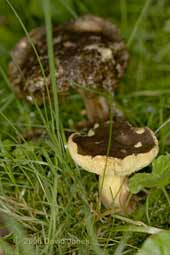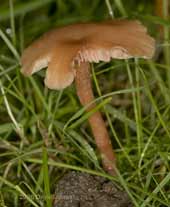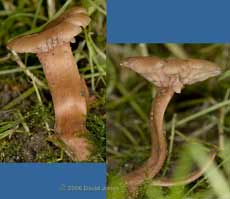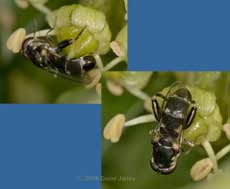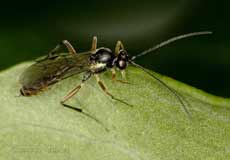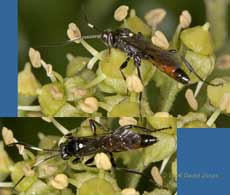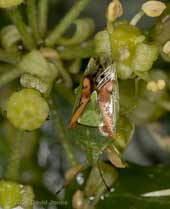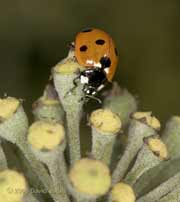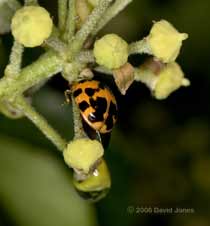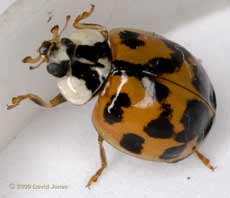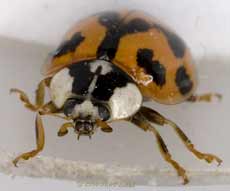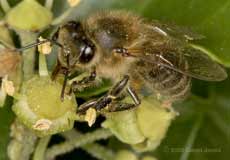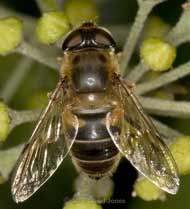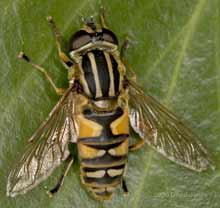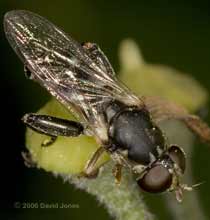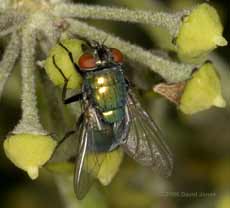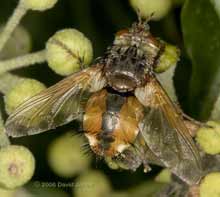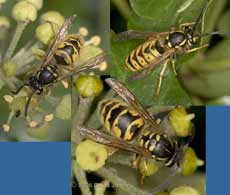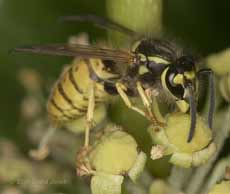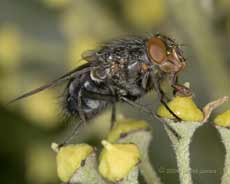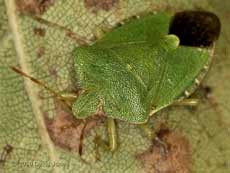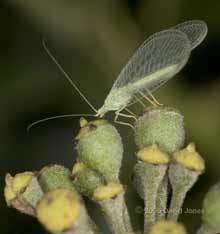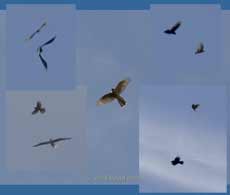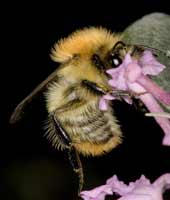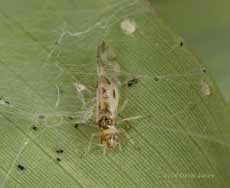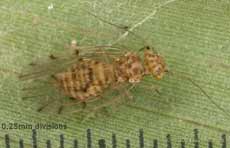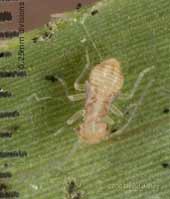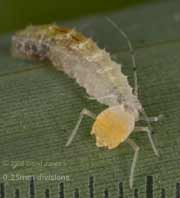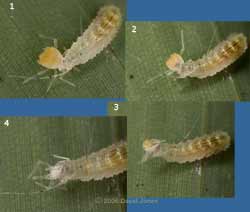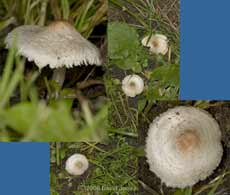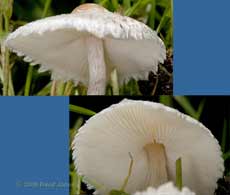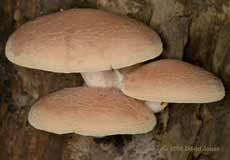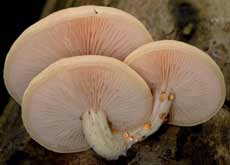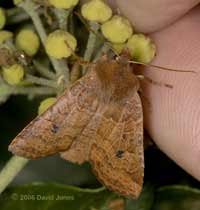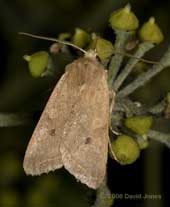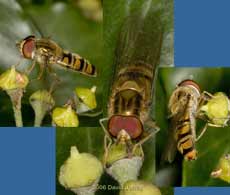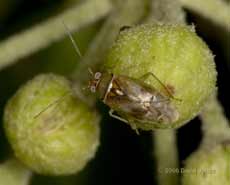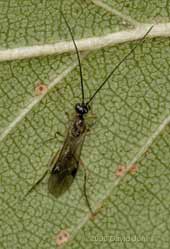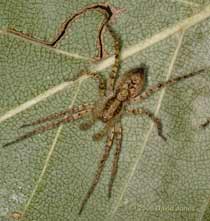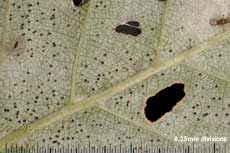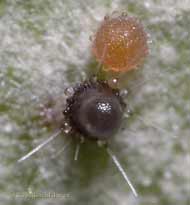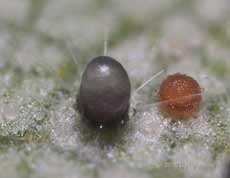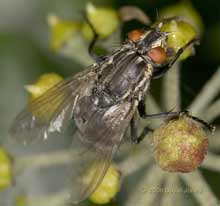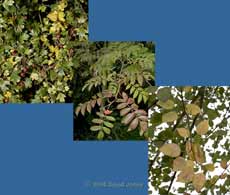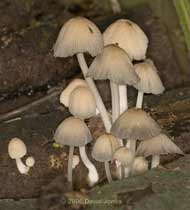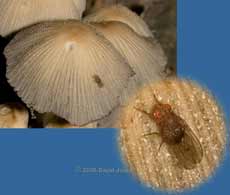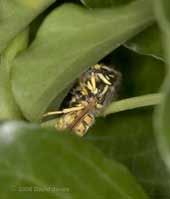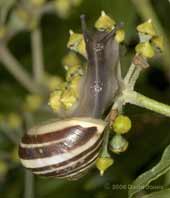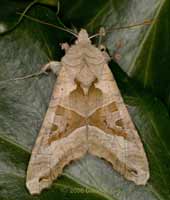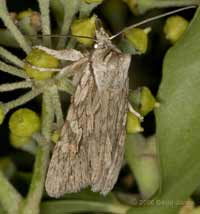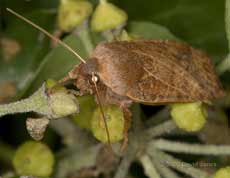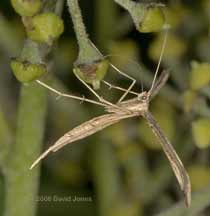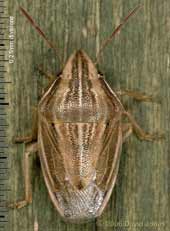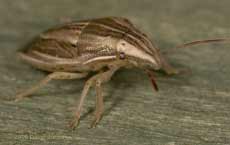Go to the last entry on this page .....Go to previous entry11 October - We have been hearing thunder since the early hours of the morning, and as I write this (10.20am) the skies outside are dark, with the occasional flash of lightning and the rain pouring down. I went out onto our veranda a few minutes or so ago and checked the light levels with my camera - a picture of the Hawthorn would have required a 2.5sec exposure at f/2.8! Surprisingly, the Sparrows, Goldfinches and Blue Tits are still busy feeding despite the conditions. We continue to see the group of 8 to 10 Goldfinches coming to feed. The grey skies gave way to a very short period of brightness at lunchtime, and an inspection of the Ivy showed that the wasps had the place almost completely to themselves, with the exception of a couple of hoverflies and Bluebottles, and the first Yellow Dung-fly that I've seen this autumn. Last year I watched these ambushing other insects that were visiting the ivy. While I watched the top of the ivy, parts were in constant movement, not from any breeze (the air was still) but because of the movement of Sparrows and other birds underneath its cover. Also, I was attracted to a different, chirpy call which turned out to be a Wren. As I write this the rain has returned. After more rain, things brightened up a bit during the afternoon and I headed out the garden again. Before spending more time up the tower I took a few more fungus photos.
The first is the fungus that I photographed on the 6th. At least, that is the fungus in the background and it is now decaying rapidly as another grows in front of it.
In a few places amongst the grass there are pink coloured fruiting bodies like this one, with quite a thin stalk.
However, this one seems to have a defect in that its stalk is ribbon-like.
When I climbed up the tower the sun came out for a short time but despite that, the Red Admirals didn't appear.
The wasps continued to dominate, and only a handful of hoverflies appeared, including my first sighting of a small species visiting the flowers. It didn't land in a good spot for photography so these were the only images I could collect.
Another sawfly appeared for a short time,
as did this Ichneumon fly, which I think may be Ichneumon stramentarius.
Yesterday I caught a glimpse of a shieldbug. Today I spotted it again, and this time I was able to get this one photograph before it disappeared again behind a leaf - Tim Norriss has identified it as a Juniper Shield Bug (Elasmostethus tristriatus). I should have known that, because, looking back into my diaries I see that I'd photographed one here previously (on 18 October 2004), also on the Ivy flowers.
Having seen a 2-Spot Ladybird yesterday (it is still on the same branch today), today I spotted(!) the first 7-spot Ladybird of the year in our garden.
I was still watching the Ivy when, at 3.55pm something flew into the Ivy from over the neighbouring garden. As it landed I pointed my camera at the new arrival as it withdrew its wings under its elytra - it was another ladybird, but clearly different to any I have seen in the garden before. It was large and with a complex pattern on its elytra, and my instant thought was Harlequin Ladybird (Harmonia axyridis). As soon as it appeared to settle I dashed to the house to get a container, and I now have it secure while I decide what to do next.
If I'm correct, this is bad news, especially after the bad year we have just had as far as native ladybirds in the garden is concerned. Harlequin Ladybirds are an alien, Asian species that were introduced to the USA and mainland Europe as a biological control species.
However, it devastated native ladybird species and has become a pest. It was first identified in the grounds of an Essex pub in September 2004 and has been spreading from the south-east ever since. This individual measures over 7mm in length.
I have sent off a report form to the Harlequin Ladybird Survey and I will probably send off the Ladybird as requested on the website (if they still want live examples). Now I'm waiting to see if they will confirm my suspicions. On a positive note, my copy of "Field Guide to the moths of Great Britain and Ireland" arrived this morning and I think that it will be getting a lot of use over the years to come.
12 October - A bright and sunny morning, and confirmation of the Harlequin Ladybird. I suppose they were bound to turn up eventually, but I was hoping that time would be delayed as long as possible! After yesterday's excitement, today has been quiet - no ladybirds of any kind, and just a couple of Red Admirals as the Ivy approaches the end of its flowering period. Although there are still flowers opening, the Ivy's scent is hardly noticeable now, and the visiting insects have to spend more time searching for good nectar or pollen sources.
This afternoon, when I spent an hour watching the Ivy, there were fewer wasps than previously, and I saw only a couple of bees. This one spent ages on just one inflorescence and showed no interest at all in the stamens and their pollen.
Even the hoverflies were fewer in number today, despite the sunshine. I only saw three or four of these (Eristalis tenax).
I thought that I saw a couple of these, but photographs taken some twenty minutes apart showed that it was the same individual returning for a second feed. I believe it to be Helophilus pendulus, a colourful, and very common species.
Yesterday I reported seeing a much smaller hoverfly, but could only get rather poor images. Today there appeared to be several visiting the Ivy and this time I managed to get closer, and if you click on this image you will see several shots of it from different angles. You will see pale sides to its abdomen which has become distended as it has fed. I still need to identify the species.
Even the flies seemed fewer in number today, although they clearly out-numbered the wasps. They weren't the most numerous, but the Greenbottles really show up in the sunshine because of their metallic sheen.
There was one late newcomer to the Ivy today in the form of this less than pretty species (at least three individuals), which I think may be Tachina fera. If it is, then its larvae parasitize butterfly and moth caterpillars.
For the second night running I didn't see any moths when I went out to check the Ivy at around 10pm.
13 October - After a misty start the day has been gloriously sunny with a temperature high of 17C. At the beginning of the afternoon I headed for the tower again, and within minutes had the frustration of seeing a Hornet fly low over me, only to land just out of sight again. A few minutes later it passed over me again as it left! It didn't appear again during the two hours I spent there.
After yesterday's comparatively quiet activity, things were very busy at the top of the Ivy this afternoon. Just a couple of Red Admirals visited briefly, but there were lots of wasps. They vary quite a bit in size, and there is some variation in their markings, but at the moment I'm inclined to think that they are Common Wasps.
In this shot you can see the wasp using its antennae to test the flower's surface
In contrast to the large numbers of wasps, I don't recall seeing any Honey Bees today, and I only saw one Bumble Bee (with a white tail).
There were lots of flies about, although I don't think there were any T. fera about. This photograph of a large Bluebottle shows its seemingly articulated proboscis to suck up liquids from the flower surface.
No new hoverfly pictures today - there were a lot about similar to those already photographed, although I didn't see the small, dark one photographed yesterday.
A couple of 'different' insects made an appearance. First of all, this Green Shield bug 'sunbathed' on a Birch leaf before heading into the Ivy. These usually turn a deep bronze colour in Autumn, but this one shows no sign of doing that yet.
The next was this Green Lacewing. I usually get to see these after dark but this one was obviously anxious to feed.
The Sparrowhawk didn't have the sky to itself for very long because a rook decided to follow the gull's example and mob it for a second time before it was finally allowed to continue its upward spiral. As I was set up for close-up photography these images had to be cropped drastically - hence the poor quality.
Finally, an image from the other end of the garden. The Buddleia has just a few flowers left now, and while Sheila and I were having lunch on the veranda, this bee visited each one of them. It's most likely to be Bombus pascuorum, although a close inspection would really be needed to be sure.
14 October - A dull morning after a misty start - disappointing after yesterday's sunshine. The Ivy will have to wait until later in the day. I went out to harvest some aphids for the Harlequin Ladybird and was distracted by Barkflies on the bamboo plant.
It was only in September this year that I first noticed this group of insects and photographed two species that I found on the Birch and a Bamboo plant. This is one of them (Valenzuela flavidus), this time under a silk canopy that I didn't realise they produced. The insect is about 4mm in length.
On another bamboo leaf I found what looks like a third, and smaller barkfly species for the garden. Although not seen in the photograph, there was also a silk canopy over this one,
and also this nymph near to it. Notice how it seems to have a silk 'safety line'. If the weather stays glum I will probably spend more time taking photographs of these today rather than insects on the Ivy!
I'd like to take this opportunity to apologise to Bob Saville of the Lothian Wildlife Information Centre who is the recorder for barkflies in the UK. He identified the first two species for me, but I completely forgot to add the information to the diary and to thank him for his help.
One of the bamboo leaves that I collected also had on it what I think is the larva of a Syrphus genus hoverfly, measuring about 4-5mm in length. My attention was drawn from the Birchflies to it when it caught one of the aphids that were on the leaf.
Over the next ten minutes it set about eating the aphid from the inside, and this sequence records the event from just after the previous picture had been taken to just before the 'empty' skin was discarded. Click on the picture to see a larger version of this combined image, or click here to see them as separate images, with a short bit of additional information.
Another fungus has popped up in the garden, this time between the caravan shelter and the garden path. The two close-ups are of the fruiting body at the bottom end of the central image. The cap measures 3cm across,
and the gills are white. The stalk is quite short ( the rim of the cap is just 2cm above the ground) so a mirror had to be used for these shots - white object at the bottom of the lower image is the rim of the actual fungus! My search through my fungus guides has, as usual, been inconclusive so I shall leave the ID to the experts.
Back on the 10th I recorded the orange coloured fungi (Rhodotus palmatus?) growing on a tree stump. Since that time, the caps have opened up, and now the largest one measures 4.6cm across. They still retain their wrinkled look, although not quite as well defined as in the original picture.
Now that the caps have opened the gills are clearly seen (again, with the help of a mirror), and there are only a few small drops of liquid in evidence. The tiny object on the rim of the upper cap is a tiny larva that appeared to be feeding there.
15 October - A dry day with hazy sunshine.
Last night I spent a short time up the tower at around 10pm, and saw just three moths, two Chestnuts (Conistra vaccinii),
and what I think may be a Yellow-line Quaker (Agrochola macilenta). Although I didn't get to take a photograph of it, I was surprised to see a Green Shield bug up amongst the flowerheads.
Today I spent about an hour there again around lunchtime. It was quite busy on the Ivy, and it was interesting to note a change in the balance of insects visiting the Ivy. There appeared to be more hoverflies than wasps today, with the larger species I've already photographed in the last week predominating. There were also several Syrphus hoverflies. I couldn't decide if there were as many hoverflies as there were other fly species.
For the first time since I started watching the Ivy this Episyrphus balteatus appeared for a short time.
Two Red Admirals paid brief visits to the Ivy, and a couple of snails were up amongst the flowers despite all the buzzing going on around them, but no hornet.
The only bug I saw there today was this small bug, probably a Common Flower Bug (Anthocoris nemorum).
Going back to last night, I spent a while looking at the Birch, this time finding four Orange Ladybird adults. There was also this ichneumon fly. It's usual to find flies of various sorts using the undersides of the leaves to roost overnight,
and just occasionally a spider will turn up, as did this one with a body length of about 6mm.
16 October - A dull morning gave way to brighter conditions around lunchtime helping the temperature up over 18C, warmer than the last few days. Despite the weather, the only time I was outside was when we had lunch on the veranda.
The undersides of the leaves have white patches where the mildew has spread over the surface (and grazed on by the Orange Ladybirds), and they are peppered with small dots, the largest measuring up to around 0.3mm in diameter, and varying in colour from white, through orange to black in colour.
A closer look reveals their external structure. I haven't been successful in finding any information on the web, but an old Botany textbook (Textbook of Theoretical Botany - Vol 1 by McLean & Ivimey-Cook; 1951) has given me a few clues in its description of the Hop Mildew (Sphaerotheca humuli). The black structures seem to be perithecia. Each perithecium is a mass of hyphae, that come together in a ball which gradually turns from white to dark brown. During that process sexual organs develop in (or on) it, although the book is a bit vague about exactly what occurs.
The spines that develop around it are single-celled and their shape, which is a characteristic used to establish the genus that the mildew fits in.
The simple, straight nature of these spines seem to put this mildew in the same genus (Erysiphe) as the Hop Mildew.
17 October - A grey day, but dry, and with a maximum temperature of just 16C. Despite the overcast conditions, the Ivy was buzzing with activity at lunchtime, with lots of wasps, hoverflies and other flies, mainly Bluebottles, and Greenbottles.
There were also smaller numbers of other species, including several of these flies, which like very much like Flesh-flies (Sarcophaga carnaria), although there are several similar species so I can't be certain about the ID. As usual, the flower heads, at around 3mm across give an idea of the size of the fly
Having looked at the mildew on the Birch leaves yesterday, here are three images to show how Autumn is beginning to show itself on the Hawthorn, Rowan and Birch. The Hawthorn has started to shed leaves over the last couple of days with the leaves changing colour in a seemingly random way over the tree. The Rowan's leaves are showing a increasingly red colour, especially towards the extremities of the branches ( the only two berries on the tree are now bright red). Much of the Birch is still green, even if the leaves look somewhat 'tired'. but the leaves on several low branches have almost completely lost their green colouring.
Against the fence near the Ivy tree, an old log pile has produced its first fungal fruiting bodies. I'm not able to get in close to these so I cannot get pictures of the gills this time.
In this second shot of one of the largest caps you can see one of several small flies that were obviously attracted to the fungus. The rather fuzzy enlargement of the fly shows its quite simple vein pattern, although this hasn't helped me to get an ID.
18 October - A dull, overcast morning, and the forecast doesn't suggest it will get brighter.
Last night's trip up the tower yielded a few photographs, starting off with this glimpse of what is normally a daytime visitor. I occasionally come across wasps that are roosting in amongst the foliage, and this is the first I've spotted this Autumn. Shortly afterwards I found a second one in a similar pose.
Unlike the wasps, the snails continue to feed both day and night, and this one obviously liked what the flowers had to offer.
There were still relatively few moths about. The first that I spotted was this Angle Shades which looked as though it had just appeared from a roosting spot in the foliage. It spent ages on this leaf before its wings started vibrating as it prepared to fly to the flowers.
After having seen what might have been a Blair's Should-knot last week, I had this better view of one last night, although still a bit too far away to look at it closely. The only other record of one in the diary was in October 2004, what that too was visiting the Ivy.
When the moths come close enough, its always fascinating to watch them feeding. Here, one of three Chestnuts that I saw last night uses its stout proboscis to probe the rim of the Ivy flower.
Compare that with the long and extremely delicate proboscis of this Plume Moth which was feeding nearby. I find it amazing how the moth can manipulate it with such deftness.
19 October - A mild day, mainly dry after some heavy rain overnight. It's been mainly cloudy and breezy and is just starting to rain a bit at the end of the afternoon. I've not spent much attention to the garden over the last two days, but I did have one of those lucky discoveries when I walked down to the bottom of the garden this afternoon.
I noticed this Bishop's Mitre Shieldbug (Aelia acuminata) walking up the door of the Blue Tit birdbox. It's the first time I've seen this bug in the garden. This is normally found in areas of long grass, so perhaps it has been brought in from the countryside to the south of us by the southerly breeze.
Its name is supposed to reflect the similarity of the front end of the bug with the hat of a bishop, and it has a characteristically triangular, drooping snout. This individual is just over 8mm in length.
Click on the images to see larger versions - |
September trip
to
Cornwall
|
